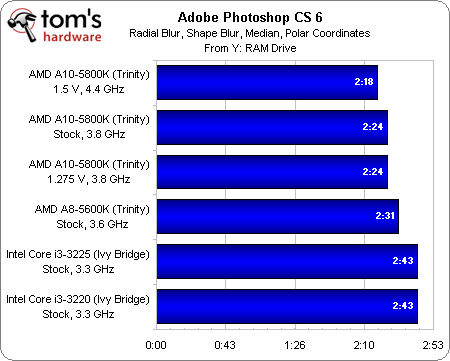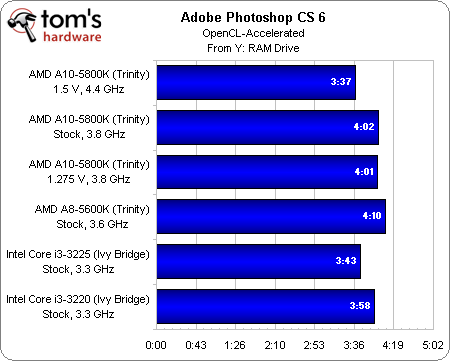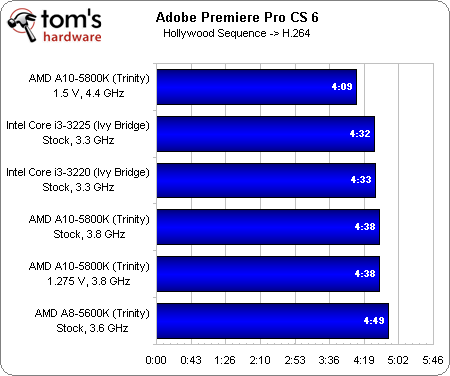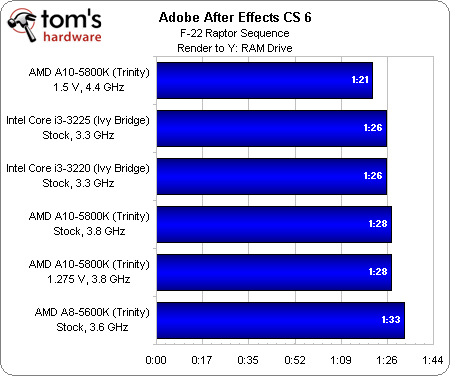AMD's Trinity APU Efficiency: Undervolted And Overclocked
We've been playing with AMD's Trinity APUs for four months, and they're just now being rolled out to the channel. This time, we take a look at the architecture's efficiency compared to a pair of Ivy Bridge-based Core i3s. Can A10 and A8 stand up to Intel?
Benchmark Results: Adobe CS6
Our Photoshop test employs a handful of filters optimized for multi-core processors. It’s purely x86-based, though, so the latest OpenCL-based enhancements aren’t reflected.
Nevertheless, AMD’s quad-core APUs outperform Intel’s Core i3s in the first example of what we’re going to see as a trend throughout testing: that is, threaded benchmarks favor AMD’s design, while an ever-shrinking collection of single-threaded metrics give Ivy Bridge’s tremendous IPC throughput advantage a stage on which to shine.
We have a completely different test able to benefit from OpenCL acceleration, too.
Because the HD Graphics 4000 and 2500 engines are OpenCL-capable, Intel actually improves its position against AMD, outperforming the A10-5800K. It takes an aggressive overclock for the flagship APU to secure a first-place spot.
This brings up an interesting question. Although AMD currently seems like the biggest proponent of addressing parallelized workloads with its graphics hardware, Intel has the same capability. Will we simply see the competition speed up alongside AMD, or does AMD have a genuine advantage? We'll see one way the company is addressing Intel's ability to follow its path to glory in our WinZip testing.
The finishing order in Premiere Pro is fairly close, with 30 seconds or so separating the first- and last-place finishers.
Both Intel chips edge past the stock A10-5800K, though, and it again takes an overclock to 4.4 GHz in order for the APU to take the lead.
Get Tom's Hardware's best news and in-depth reviews, straight to your inbox.
After Effects CS6 is an even closer race, with the Core i3s and A10 two seconds apart. Overclocked, the APU does enjoy a five-second lead, trivial though that may be.
Current page: Benchmark Results: Adobe CS6
Prev Page Benchmark Results: 3DMark 11 Next Page Benchmark Results: Content Creation-
esrever Most PC are idle or semi idle when people have them on. 90% of the time I use my PC, I do web surfing or watch video or a text editor for work, my pc is not loaded with benchmarks 24/7. If you look at idle power consumption, the trinity APUs are amazing. They easily beat out intels offerings. If you are looking at the power consumption over a month, the trinity will be much more energy efficient than the i3 for most people.Reply
-
tacoslave man getting this in a 17inch laptop with a 12 cell battery would make it an instabuyReply -
mayankleoboy1 ReplyIn the end, then, both Intel and AMD are offering you an experience. Which one do you pick?
At this price point, i would choose AMD Trinity. -
cangelini esreverMost PC are idle or semi idle when people have them on. 90% of the time I use my PC, I do web surfing or watch video or a text editor for work, my pc is not loaded with benchmarks 24/7. If you look at idle power consumption, the trinity APUs are amazing. They easily beat out intels offerings. If you are looking at the power consumption over a month, the trinity will be much more energy efficient than the i3 for most people.Happy to set a couple of systems up and let you know what I find.Reply -
mayankleoboy1 AMD should team up with developer of 7zip to accelerate it on APU's. That will make Trinity look better. A lot of people use 7zip. And most of the installation setup exe files are compressed using LZMA algorithm.Reply -
mayankleoboy1 Chris, it would be great to see some benchmarks of applications that uses the new FMA3 instructions of the Piledriver.Reply -
cangelini esreverMost PC are idle or semi idle when people have them on. 90% of the time I use my PC, I do web surfing or watch video or a text editor for work, my pc is not loaded with benchmarks 24/7. If you look at idle power consumption, the trinity APUs are amazing. They easily beat out intels offerings. If you are looking at the power consumption over a month, the trinity will be much more energy efficient than the i3 for most people.So, it's probable that we're seeing a difference in configuration. It looks like Anand is using the Gigabyte A85X board and perhaps an older driver version. I'm on the MSI board and Cat 12.8, with a different Intel setup as well. On the Windows desktop, after 10 minutes on each config, I get 59 W for Intel and 67 W for AMD at idle.Reply -
techcurious Chris, for the sake of completeness, any chance you could undervolt the i3-3225 at stock speeds and run the power consumption/efficiency tests on it? ;) ...to reveal how low the i3 can be pushed with some tweaking as well, and create the opportunity for a more fair comparison with the undervolted Trinity results.Reply -
sarinaide Thanks Chris, another great article to pass time over. You really need to comment on the forums more and more so to help out against the blatent belligerence against what AMD are trying to achieve and how they are looking to achieve it.Reply
Hopefully this articale can start to filter around particularly for the budget users which A-series is premised to target.




